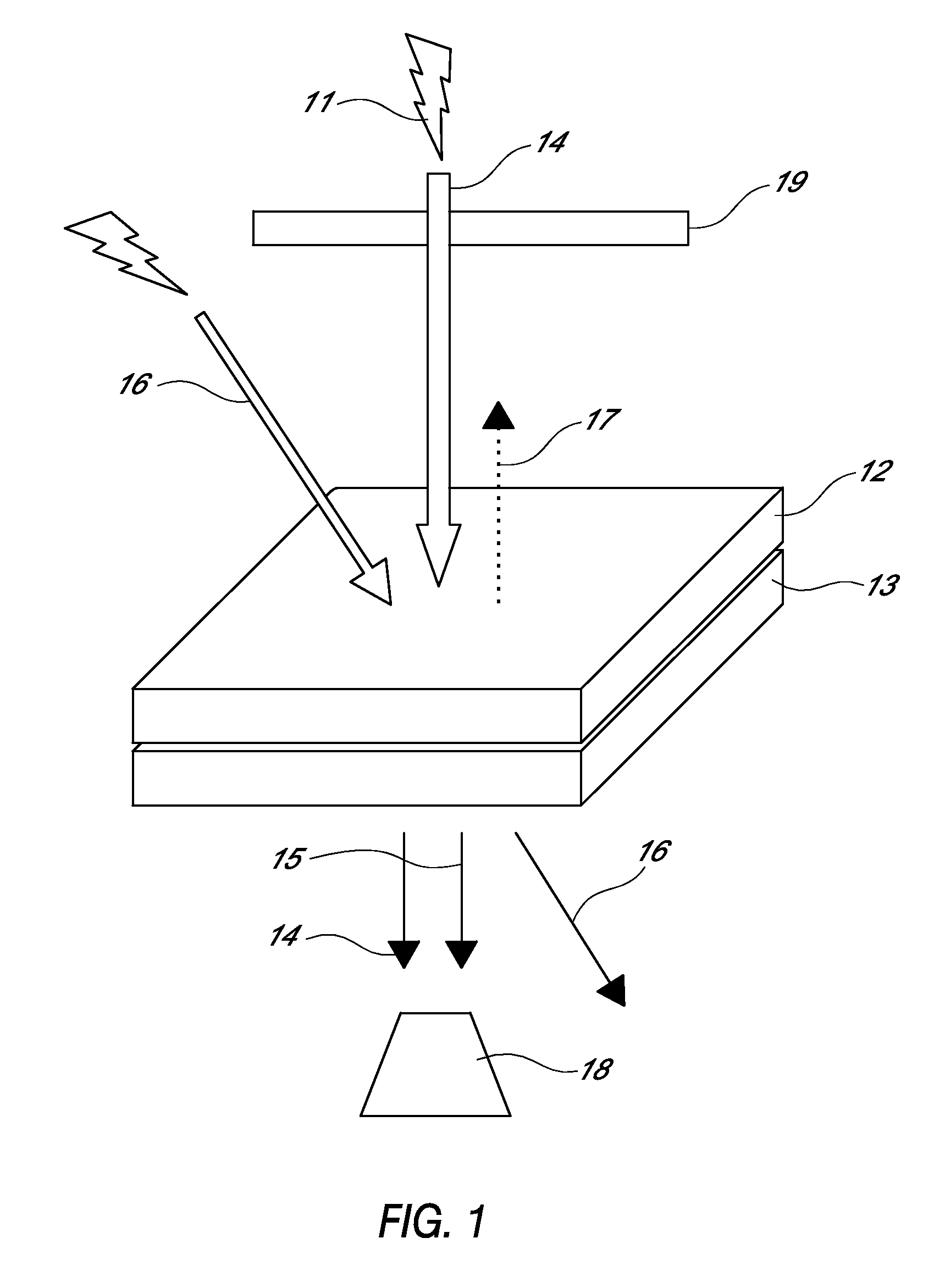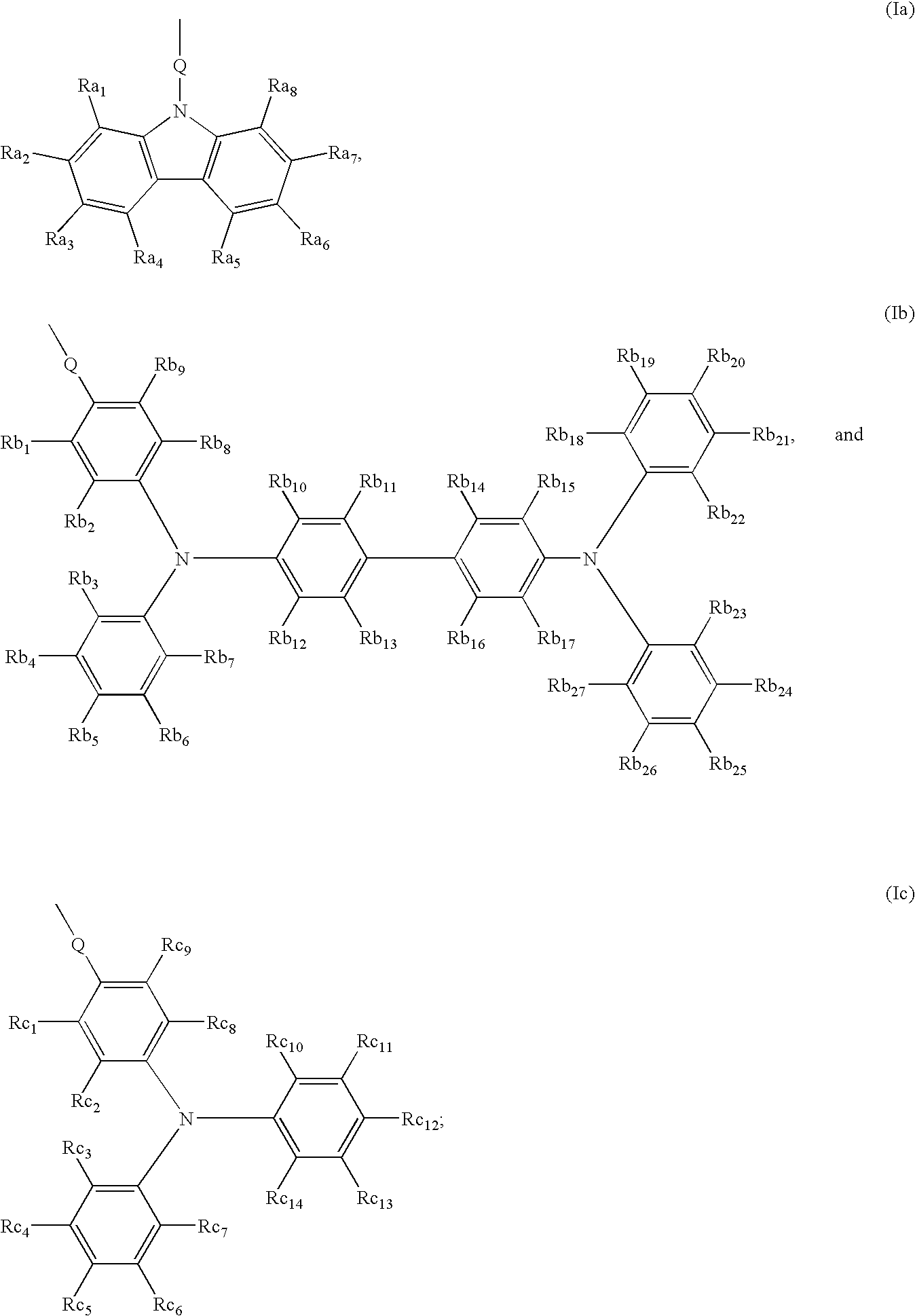Optical devices responsive to blue laser and method of modulating light
- Summary
- Abstract
- Description
- Claims
- Application Information
AI Technical Summary
Benefits of technology
Problems solved by technology
Method used
Image
Examples
example 1
(a) Monomers Containing Charge Transport Groups
[0072]N-[acroyloxypropoxyphenyl]-N,N′,N′-triphenyl-(1,1′-biphenyl)-4,4′-diamine (TPD acrylate) monomer was purchased from Fuji Chemical, Japan, and has the following structure:
(b) Monomers Containing Non-Linear Optical Groups
[0073]The non-linear optical precursor monomer 5-[N-ethyl-N-4-formylphenyl]amino-pentyl acrylate was synthesized according to the following synthesis scheme:
[0074]STEP I: Into bromopentyl acetate (5 mL, 30 mmol) and toluene (25 mL), triethylamine (4.2 mL, 30 mmol) and N-ethylaniline (4 mL, 30 mmol) were added at room temperature. This mixture was heated at 120° C. overnight. After cooling down, the reaction mixture was rotary-evaporated to form a residue. The residue was purified by silica gel chromatography (developing solvent: hexane / acetone=9 / 1). An oily amine compound was obtained. (Yield: 6.0 g (80%))
[0075]STEP II: Anhydrous DMF (6 mL, 77.5 mmol) was cooled in an ice-bath. Then, POCl3 (2.3 mL, 24.5 mmol) was ad...
example 2
Preparation of TPD Acrylate Polymer by AIBN Radical Initiated Polymerization
[0083]The charge transport monomer N-[(meth)acroyloxypropylphenyl]-N,N′,N′-triphenyl-(1,1′-biphenyl)-4,4′-diamine (TPD acrylate) (61.50 g) was put into a three-necked flask. After toluene (400 mL) was added and purged by argon gas for 1 hour, azoisobutylnitrile (138 mg) was added into this solution. Then, the solution was heated to 65° C., while continuing to purge with argon gas.
[0084]After 18 hrs of polymerization, the polymer solution was diluted with toluene. The polymer was precipitated from the solution and added to methanol, then the resulting polymer precipitate was collected and washed in diethyl ether and methanol. The white polymer powder was collected and dried. The yield of polymer was 78%.
[0085]The weight average and number average molecular weights were measured by gel permeation chromatography, using polystyrene standard. The results were Mn=20,400, Mw=42,900, giving a polydispersity of 2.10....
example 3
Preparation of TPD Acrylate / Chromophore Type 10:1 Copolymer by AIBN Radical Initiated Polymerization
[0086]The charge transport monomer N-[(meth)acroyloxypropylphenyl]-N,N′,N′-triphenyl-(1,1′-biphenyl)-4,4′-diamine (TPD acrylate) (43.34 g), and the non-linear optical precursor monomer 5-[N-ethyl-N-4-formylphenyl]amino-pentyl acrylate (4.35 g), prepared as described in Example 1, were put into a three-necked flask. After toluene (400 mL) was added and purged by argon gas for 1 hour, azoisobutylnitrile (118 mg) was added into this solution. Then, the solution was heated to 65° C., while continuing to purge with argon gas.
[0087]After 18 hrs of polymerization, the polymer solution was diluted with toluene. The polymer was precipitated from the solution and added to methanol, then the resulting polymer precipitate was collected and washed in diethyl ether and methanol. The white polymer powder was collected and dried. The yield of polymer was 66%.
[0088]The weight average and number averag...
PUM
| Property | Measurement | Unit |
|---|---|---|
| Thickness | aaaaa | aaaaa |
| Electric charge | aaaaa | aaaaa |
| Wavelength | aaaaa | aaaaa |
Abstract
Description
Claims
Application Information
 Login to View More
Login to View More - R&D
- Intellectual Property
- Life Sciences
- Materials
- Tech Scout
- Unparalleled Data Quality
- Higher Quality Content
- 60% Fewer Hallucinations
Browse by: Latest US Patents, China's latest patents, Technical Efficacy Thesaurus, Application Domain, Technology Topic, Popular Technical Reports.
© 2025 PatSnap. All rights reserved.Legal|Privacy policy|Modern Slavery Act Transparency Statement|Sitemap|About US| Contact US: help@patsnap.com



